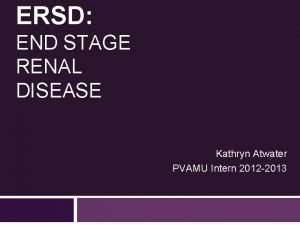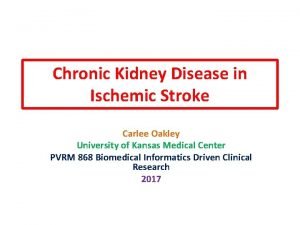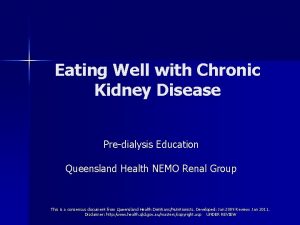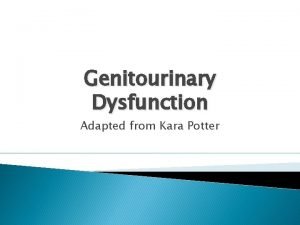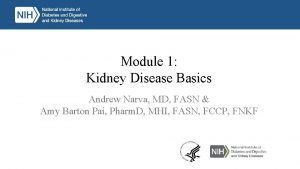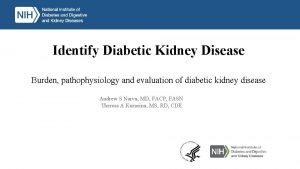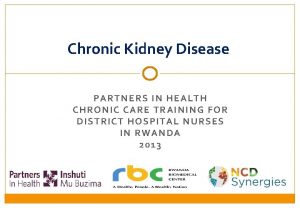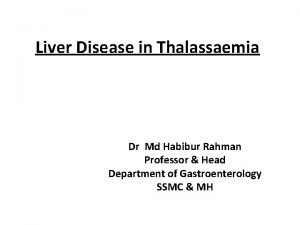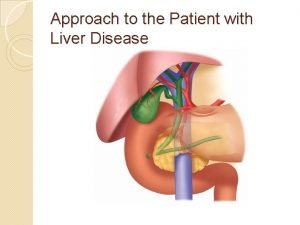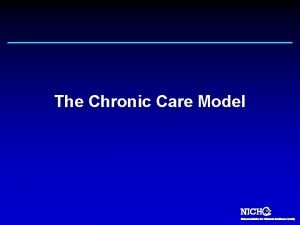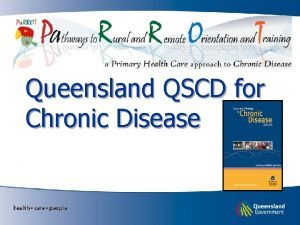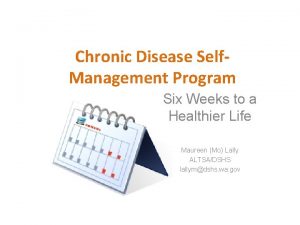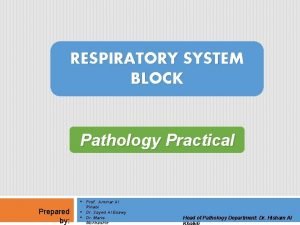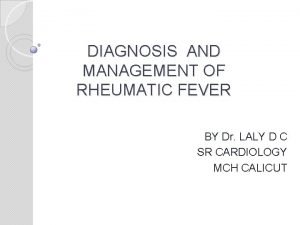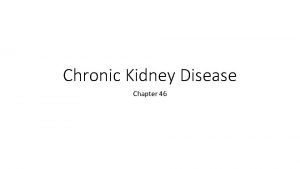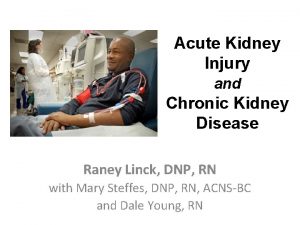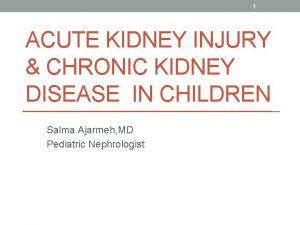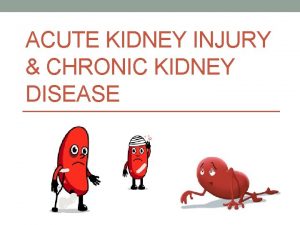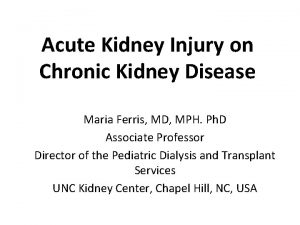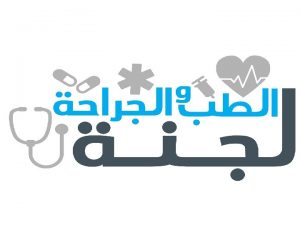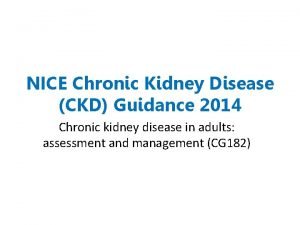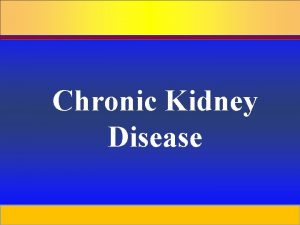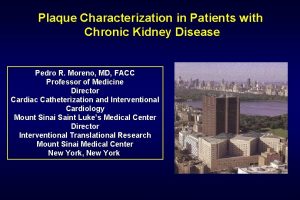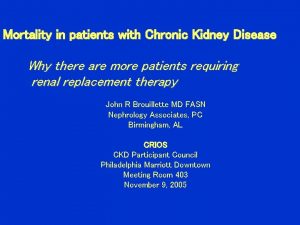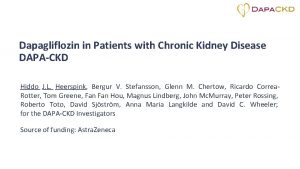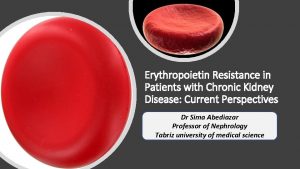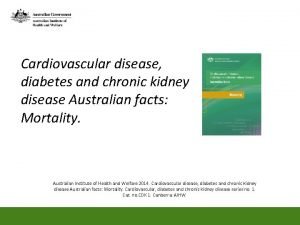Exercise for patients with Chronic Kidney Disease Green






















- Slides: 22

Exercise for patients with Chronic Kidney Disease Green Nephrology 2013 Sharlene Greenwood

Why is exercise important in CKD • Muscle wasting and weakness • Cardiovascular disease leading cause of death in CKD • Impaired capacity for activities of daily living • Effects of exercise rehabilitation interventions well documented • Routine physical rehabilitation for patients with CKD is rare

SF-36 scores in chronic disease CHF = chronic heart failure; COPD = chronic obstructive pulmonary disease; ESRF = end stage renal failure Curtin RB et al. Adv Ren Rep Therap 1999; 6(2): 133– 140

Physical function and CKD Anaemia Physical inactivity Decreased dietary intake Muscle weakness and wasting Aging Comorbidity Muscle protein catabolism > synthesis Dialysis VO 2 peak

VO 2 peak and Survival as function of baseline VO 2 peak for 175 ambulatory ESRD patients > (Sietsema et al (2004) Kidney International, 65, 719 -724)

Inactivity and survival on dialysis 2264 incident dialysis patients; sedentary, active; 9– 12 -month survival O’Hare AM et al. Am J Kid Dis 2003; 41(2): 447– 454

Deficits in physical function between ESRF patients and normal patients • • • VO 2 peak (ml. kg. min-1) STS 60 (n) STS 5 (secs) Stair climb (secs) Stair descent (secs) Patients Healthy (n=45) controls (n=22) 17. 6 6. 1 21. 2 7. 5 15. 7 11. 5 14. 6 9. 2 16. 9 11. 8 26. 2 9. 1 30. 2 6. 2 9. 8 3. 5 8. 4 2. 9. 2 2. 8 % deficit 33 30 60 74 84 Naish P. Unpublished observations

The evidence • 30 years of research investigations into effects of exercise training on physiological and patient outcomes • 4 systematic and meta-analytic reviews – – Cheema and Singh 2005 Segura-Orti 2010 Smart and Steele 2011 Heiwe and Jacobson 2011

Aerobic exercise • Indices of CV fitness - Improved VO 2 peak (17 -50%) -Dialysis v Non-dialysis • Functional capacity -No significant objective improvements -Small number RCT’s, Specificity of training • Quality of life Indices - Improvements in physical component

Resistance only exercise • Very small number RCT’s (4) • No index of CV fitness • Muscle strength and cross-sectional area improved (Hiewe 2011) • 2 studies - no difference in strength and functional capacity, but large significant changes in HRQOL (Johansen et al 2006, Cheema et al 2007)

Resistance and aerobic training • 9 studies used combination training • Demonstrated large effects on indices of CV fitness, not accompanied by improvements in functional capacity indices • Significant improvements in resting diastolic and systolic blood pressures following any type of exercise training for at least 6 months.

Exercise and the environment Obesity Quality of life CVD Depression Fatigue Exercise Rehabilitation Mobility Diabetes BP Self efficacy Dialysis adequacy

Exercise training for patients with CKD

Exercise on dialysis

Exercise on dialysis • Captive audience – will enhance adherence • Supervised by dialysis staff Ø Medical surveillance Ø Motivation from staff and peers • No extra time required (reduce patient time burden) • May stabilise haemodynamics during the treatment • Less cramping / hypotension • Less post-dialysis fatigue / stiffness • Increased protein uptake (with IDPN – Pupim et al) • Increased clearance of K+, reduced rebound of urea, creatinine, K+ (Viathlinigading, Kong, Parsons)

• Changes environment in the unit from ‘illness’ to ‘wellness’ • Changes staff attitudes / expectations of patients (and patient expectations for their life on dialysis) • If a part of routine treatment, then will be more sustainable • FUN!

Potential Barriers Weight gain – nutritional Potential • barriers difficulties • Efficient use of time – sleep disorders • Lack of research – safety, effectiveness • What type of equipment to use? • Space in the unit • Satellite units • TIME / Finance for staff • Monitoring the programme • Fatigue, especially postdialysis • Lack of motivation • Multiple hospital visits (dialysis 3 X / week) • Anaemia • Fistula / PD access – use of weights / swimming • Medication side effects • Peripheral neuropathies (diabetics) • Getting the patient on board!

Other exercise options! • Renal Rehabilitation class • Home exercise program – walking and cycling diaries • Exercise on Referral Gym program

The current position • • • Enthusiastic researchers and clinicians Good quality research Existing NHS renal exercise programmes Adopted by BRS Collaborative links Difficult financial climate

The next steps… • Exercise and haemodialysis – NIHR HTA bid – The PEDAL Trial • The effects of exercise on the prevention of CVD / progression of CKD in the predialysis population • The effects of exercise on long-term KTx outcomes, and cardiovascular risk

The future • • • High quality collaborative research A marriage of research and clinical ideals Prevention and rehabilitation in the NHS Increasing the profile of exercise and CKD Influencing policy Increasing collaborative links

BRS RN • • • British Renal Society Rehab Network 100+ members Task and finish work stream Website Support research and clinical implementation of exercise for patients with CKD • sharlene. greenwood@nhs. net
 Nephrology near atwater
Nephrology near atwater Carlee oakley
Carlee oakley Nemo dialysis
Nemo dialysis Kara potter
Kara potter Choronic kidney disease
Choronic kidney disease Albumin kidney disease
Albumin kidney disease Albumin kidney disease
Albumin kidney disease Symptomatic polycystic kidney disease
Symptomatic polycystic kidney disease Red green show
Red green show Chronic granulomatous disease
Chronic granulomatous disease Stigmata of chronic liver disease
Stigmata of chronic liver disease Jewish chronic disease study
Jewish chronic disease study Dcld vs cld
Dcld vs cld Stigmata of chronic liver disease
Stigmata of chronic liver disease Nonalcoholic fatty liver disease
Nonalcoholic fatty liver disease Kate lorig chronic disease self-management
Kate lorig chronic disease self-management Wagner chronic care model
Wagner chronic care model Chronic disease
Chronic disease Decompensated cirrhosis
Decompensated cirrhosis Chronic disease
Chronic disease Enfisema pulmonar tem cura
Enfisema pulmonar tem cura Chronic rheumatic heart disease
Chronic rheumatic heart disease Communicable disease and non communicable disease
Communicable disease and non communicable disease
